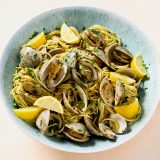The bigoli emerges from the bronze die thick, rough and hot to the touch, snaking itself into coils that slink over the cook’s outstretched hand to form bundles of fresh pasta he arranges one after another in a tray. It’s one of the sexiest things I’ve ever seen, pasta so fresh and extruded with such pressure that it steams.
I’m at Perduto, a canal-side restaurant in Venice where the pasta is made in 6-kilo batches each morning in the front window. Of course, this being Venice, by that time the tables outside already are full. Here, the drinking and eating start early, Aperol spritzes and wine lining up by 9 a.m.
Inside, the staff mounds a long copper and marble bar with cicchetti, savory nibbles destined to be nestled onto crostini or polenta. At Perduto, a space that has been home to one restaurant or another since at least the 1800s, most of those nibbles involve seafood of some sort—plump grilled squid, octopus salad, baccalà mantecato (a pâté made from dried cod).
Walk down the bar and the tables cluster. Because the kitchen is small, cooks spill into the serving area, dining tables becoming prep space. Garlic chopped here, seafood shelled there, salting sliced tomatoes to the side. The result is a delicious onslaught of aromas that makes you want everything on the menu.
And that pasta in the window? It is for bigoli con vongole, or the dish we know better as spaghetti and clams (bigoli being the rougher, thicker Venetian cousin of spaghetti). It’s why I’ve come to Perduto. And though the dish is ridiculously simple, I quickly learn that, as with so many Italian recipes we think we know, it’s the small details we overlook that matter most.
Chef Gianpiero Turdo offers to walk me through the recipe, the whole thing taking just 15 minutes. A fast and very active 15 minutes!
Turdo begins by warming olive oil, garlic and parsley in a large skillet. When we can smell the cloves, he discards them. They’ve done their job of flavoring the oil. He then adds several cups of the local and so very fresh caparossoli clams. As they start to sizzle, he adds a splash of white wine, then pops on a cover.
The pasta then goes into boiling water for a spare 4 minutes. The pasta isn’t even halfway done, but the clams have popped open, smelling sweet and briny. Turdo scoops out the partially cooked bigoli and heaps it over the clams along with ladlefuls of the starchy water it was cooking in.
That’s when the tossing begins. Holding the skillet firmly by the handle, he jerks it back and forth, turning the water, pasta, clams and their juices into a delicious tangle. It’s that movement—many minutes of it—that is the secret ingredient to this dish. The oil, starch and clam juice emulsify, creating a thick sauce that coats.
The dish is done. And as I fork up those tender, thick strands and plump clams, I find it shocking how so few and such simple ingredients can combine into a dish of wonderful briny-savory-sweet complexity.
With Spaghetti and Clams, the Sauce Is in the Shell
J.M. Hirsch

Get the Recipe
Spaghetti with Clams (Spaghetti con Vongole)
At Perduto, fresh pasta is extruded with so much pressure it steams.
Photos: Christopher Warde-Jones (fresh pasta); Connie Miller of CB Creatives (spaghetti); Styling: Monica Mariano







